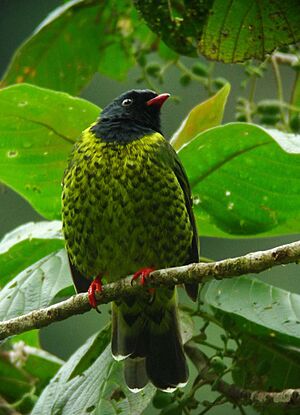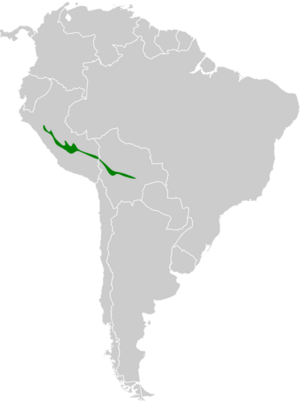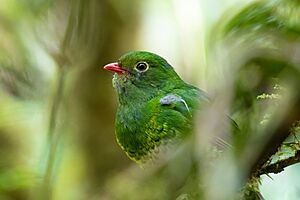Band-tailed fruiteater facts for kids
Quick facts for kids Band-tailed fruiteater |
|
|---|---|
 |
|
| Male | |
| Conservation status | |
| Scientific classification | |
| Genus: |
Pipreola
|
| Species: |
intermedia
|
 |
|
The band-tailed fruiteater (Pipreola intermedia) is a cool type of bird that lives in the high mountains of Bolivia and Peru. It's part of the Cotingidae bird family. This bird is a bit plump and mostly green. It has special V-shaped marks on its sides and a tail with a black band and a white tip.
Male band-tailed fruiteaters have a black head and a black patch on their chest, plus a thin yellow ring around their neck. Females don't have these features. Both male and female birds have bright red beaks and legs. This bird is quite common and lives in a large area. Because of this, experts say it is a "least concern" species, meaning it's not currently in danger.
What Does the Band-tailed Fruiteater Look Like?
The band-tailed fruiteater grows to be about 19 centimeters (7.5 inches) long. An adult male has a shiny green-black head and a black patch on its chest, called a bib. This bib has a bright yellow edge.
The top part of the male's body is a medium green. It has black, V-shaped marks on its sides. Its tail is green at the base, then has a black band, and a whitish tip. The underside of the bird is yellowish, with green spots or stripes.
Female band-tailed fruiteaters look a lot like the males. However, they do not have the shiny black head, the black bib, or the yellow neck ring. The black band on their tail might also be lighter. Both male and female birds have yellow eyes and bright red beaks and legs.
This bird looks a lot like the green-and-black fruiteater. But the green-and-black fruiteater is smaller. Its chest patch is more green, and the yellow area around it is not as clear.
Where Does This Bird Live?
This bird lives in the mountain forests on the eastern side of the Andes mountains in South America. You can find it from central Peru all the way to western Bolivia. They usually live at high places, from about 2,300 to 3,000 meters (7,500 to 9,800 feet) above sea level.
Sometimes, in the southern parts of its home range, you might find it at slightly lower altitudes. The band-tailed fruiteater generally lives higher up in the mountains than the green-and-black fruiteater.
Is the Band-tailed Fruiteater Safe?
The number of band-tailed fruiteaters seems to be staying steady. These birds live in a very large area and are quite common. Because of these reasons, the International Union for Conservation of Nature (IUCN) has decided that their conservation status is "least concern". This means they are not currently at risk of disappearing.



